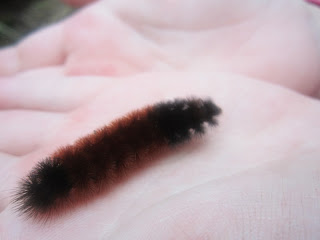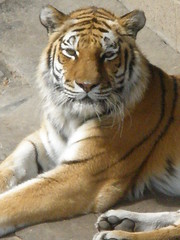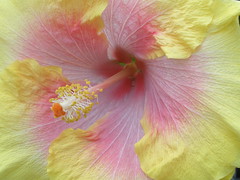On
5 Kids and a Dog, there's a series called the
ABCs of Homeschooling. This week's letter is "Z."

...is for Zoo.
Some of the most vivid memories the girls have are times when they have visited zoos and had the opportunity to interact with and learn about the animals.
In 2009, the Minnesota Zoo hosted a special African exhibit. As part of it, visitors could feed the giraffes a treat. The girls both were able to feed a giraffe and see one up close.
Olivia feeding a giraffe.
The giraffe was so gentle and provided the girls with a memory that they will always remember.
Sophia was able to spend a bit of time with the giraffe
after feeding it a special treat.
The girls also have challenged themselves to do things that were a bit "scary" for them - like touching freshwater stingrays. They thought they felt soft...leathery...and a hint slimy. After touching one stingray, they wanted to touch more of them.
The girls touching freshwater stingrays.
This was taken in 2011 in Mystic, Connecticut.
Another fun - and unexpected - memory was made in Maine. Although technically not a zoo, the
Maine Wildlife Park has many animals that have come to them who were orphaned, injured, or raised by humans who realized they were unable to care for them any longer.
These animals are unable to be released into the wild since they would be vulnerable or unable to survive on their own. So, the Maine Wildlife Park cares for them and gives the public an opportunity to learn more about the wild animals that can be found in Maine.
At the park, the girls each bought a handful of food for a quarter, and fed it to the bears.
Sophia and Olivia feeding the bears in Maine.
It was interesting to be so close to the bears and hear them breathe as they searched for the food the girls gave them. We talked about the bear that visited me many years ago when I was camping in Grand Marais.
I had described what the bear sounded like in the middle of the night...but until they heard the bears breathing, I don't think they knew what it would have sounded like. For me, hearing that black bear breathe brought me right back to the moment in the tent when I - along with my dog (Casey) - were truly scared for what could have happened if the bear ripped open the tent.
But I digress....let's refocus on zoos and homeschooling.
By visiting zoos, the girls have been able to see animals up close that they have only read or heard about through homeschooling.
In early-September (2011), Sophia, Olivia, and I visited the
Roger Williams Park Zoo in Providence, Rhode Island. It's one of the oldest zoos in the United States, being founded in 1872.
One of the reasons I wanted to take the girls there was because there were elephants - animals they have never seen in "real life."
The day we visited it was raining and the day after Labor Day, so there were very few people there. We went to the building where the giraffes and elephants could come inside. On this particular morning, the staff was bringing in the three elephants so they could check them out as well as provide foot care for each of them.
One of the staff members talked with the girls for a long time and answered each of the questions that they had about elephants.
After that, the girls saw them:
- bring the elephants in (one of the elephants was even holding the tail of the elephant in front of it),
- ask the elephants to do certain tasks (e.g., lift their trunks so the staff could make sure their mouths were healthy and there were no problems),
- give them water by filling their trunks (when the elephant had enough water in its trunk, it would lift it to its mouth and release it there, and then put its trunk down for more water from the hose),
- wash their feet, and
- begin with the foot care/trimming.
One of the elephants receiving foot care
after its feet and legs had been washed.
The girls have been able to safely see animals up close and learn about them.
The girls saw the grizzly bear up close.
Check out those claws.
Lion cub gnawing on a bone.
One of Olivia's favorite animals is the lion.
Seeing the cubs (there were three of them)
was such a highlight of the visit to the zoo
in Duluth, Minnesota.
What is nice for the girls too is that they can visit their favorite animals year after year and see how they are doing. This sense of connection and continuity throughout the years is important to them.
The girls enjoy seeing the Siberian tiger
every time they visit the Como Zoo.
They also are particularly happy to see the animals have living spaces that are reflective of the environment in which they live. For a few years, the Como Zoo worked on upgrading the polar bears' living space.
This summer, the polar bears moved into their new space; and the girls were so excited to see them have grass, water, and more natural space in which to live.
One of the polar bears in his new home.
He was enjoying being in the grass
while his brother played in another area.
Being able to see aquatic life also has been a highlight of zoo and aquarium visits for the girls. Learning about life in the sea has been fascinating for them for many years.
The coral and fish display mesmerized the girls for a long time.
They drew pictures of what they saw in their nature journals.
The girls also have taken classes at zoo to deepen their knowledge about wildlife and the animals that live there.
Class about eggs at Como Zoo.
This class was for homeschool families.
They enjoy the displays and interactive learning stations that some of the zoos offer.
Olivia comparing her hand to that of a Siberian tiger's paw.
Being able to touch and explore items helps process what they are learning on a different level.
Olivia getting a closer look at a
preserved hammerhead shark head.
She is fascinated with sharks,
so this was a great way to learn about them.
Sometimes going to the zoo has led to unexpected connections with other things we have been studying. For example, one year we had just completed a unit study on Madagascar and the girls learned about the elephant bird (an extinct animal that once lived on the island of Madagascar).
We decided to visit the Minnesota Zoo since we had not been there for a while. As we were walking through a section of the zoo, we saw a replica of the elephant bird egg. This was a perfect tie-in to what I had taught them. They also saw other animals from Madagascar that were at the zoo.
The girls by a replica of an elephant bird egg.
Going to zoos have provided other opportunities beyond learning about animals. They have given the girls time to play...
The girls playing in the discovery room at the Minnesota Zoo.
They are pretending they are wildlife veterinarians.
to see art...
Sculptures outside of Russia's Grizzly Coast exhibit
at the Minnesota Zoo.
to see flowers...
Hibiscus at the Como Conservatory which is
connected to the Como Zoo.
to see and learn about bonsai...
Bonsai forest at the Como Conservatory
which is part of the Como Zoo.
and to see a Japanese garden.
The girls overlooking a pond at the Japanese Garden
at the Como Zoo and Conservatory.
Zoos have been an integral part of homeschooling since we began several years ago. Being able to visit local zoos as well as ones at places where we've traveled has augmented what the girls learn in books they read and videos they watch.
The impact of being able to visit zoos has helped spark further interest in science, wildlife, and care for the environment. For these reasons, zoos will continue to be part of homeschooling for years to come.



























































